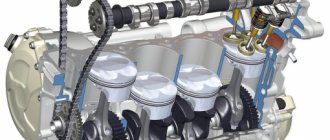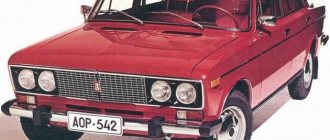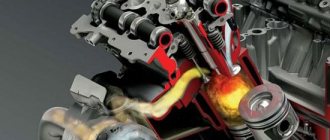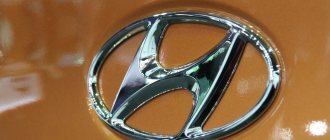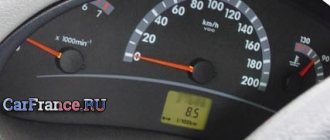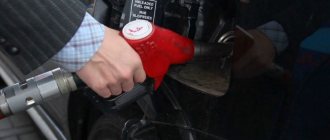- home
- Fuel
- …
Car owners often have questions at gas stations (gas stations). What kind of gasoline is best to put in your car? After all, there are 92 – 95 – 98 and even the 100th! What will happen if you fill it with 92 instead of 95, that is, how to lower the octane number? Or the 100th instead of the 95th, what will it be? After all, engines have different compression ratios, tailored to certain parameters. Will I ruin my power unit? Let's figure it out, as usual there will be a video version at the end...
At the beginning, it is worth noting those parameters and recommendations that the manufacturer indicated to you and should be used. That is, on the gas tank flap (or in the instructions) it says 92 or 95, then it’s worth pouring it in! There are also records of no lower than 95 octane number - this means that pouring less is not recommended, but 95 - 98 or 100 is possible! Now let's take a closer look.
Octane number detonation resistance
About the design and operation of a car How long can you store gasoline in a canister?
NEW Check the gasoline, then fill it up Already on sale wmv Premature combustion of gasoline is accompanied by a characteristic knock caused by detonation waves inside the cylinder. This effect is due to the low resistance of liquid fuel to self-ignition at the moment of compression. Detonation resistance is characterized by the octane number, and a mixture of n-heptane and isooctane was chosen as the standard. Commercial brands of gasoline have an octane index in the region of 70–98, which corresponds to the percentage of isooctane in the mixture. To increase this parameter, special octane-correcting additives are introduced into the mixture - esters, alcohols and, less often, heavy metal ethylates. There is a relationship between the compression ratio and the brand of gasoline:
- In the case of SJ less than 10, AI-92 is used.
- For SG 10–12, AI-95 is required.
- If SG is 12–14 - AI-98.
- With SG equal to 14, you will need AI-98.
For a standard carburetor engine, the CO is approximately 11.1. In this case, the optimal OC is 95. However, methanol is used in some racing cars. SG in such an example reaches 15, and OC varies from 109 to 140.
Comparison results
Ultimately, what is the difference between compression ratio and compression ratio? Analyzing these two terms, you can notice a significant difference. The compression ratio is a dimensionless quantity. It can be changed, but only by interfering with the engine design.
Compression can vary during the operation of the vehicle. In addition, this parameter largely depends on the compression ratio. After all, the pressure in a smaller volume will always be greater.
In other words, if the compression ratio increases, then the compression also increases.
Basic knowledge
Diesel engine compression ratio - what is it?
A flammable fuel mixture of fine particles of hydrocarbons and air is formed in the engine cylinders. Its compression ratio depends on the make of the car, the type of internal combustion engine and ranges from 7 to 10 units. A prerequisite for ignition is the presence of a spark supplied at the maximum compression moment from the spark plugs.
An undesirable phenomenon is unauthorized spontaneous ignition, as should happen with diesel fuel. As a result of such actions, negative factors will appear:
- combustion will occur at an uncontrolled high speed due to micro-explosions formed after ignition;
- the generated energy from the flash will be bidirectional both towards the piston and in the opposite direction;
- due to the fact that the valves are closed, the impact reflected from the walls affects the piston moving upward, resulting in a metallic knock from the impact of the piston pin.
Compression
Now let's get acquainted with this characteristic. Unlike the compression ratio, compression is the pressure in the cylinder at the end of the stroke. And this characteristic is a physical quantity, so it can already be measured. For this purpose, special equipment is used - a compression meter.
From a theoretical point of view, this parameter should be equal to the compression ratio. But this is all just in theory, in reality everything is different. Compression is almost always greater than the compression ratio. This is due to several reasons, which will be discussed further.
What is gasoline?
About the design and operation of the car Templates if my car is in the way. If my car bothers you sign template print
Gasoline is the lightest of the liquid fractions of oil (a mixture of light hydrocarbons). It is used as fuel in carburetor and injection engines of modern cars, motorcycles and other equipment.
Gasoline is fuel!
Gasoline labeling
In accordance with GOST 54283-2010 in Russia there is a single label for all gasoline. For example, AI-80. It is deciphered like this. A - motor gasoline, I - octane number determined by research method. 80 is the octane number itself. Also, at the end, another number can be added to the name - environmental fuel class, from 2 to 5 (for example, AI-92/4). If there is no letter I in the gasoline labeling, then its octane number is determined by the motor method (A-92).
The quality requirements for currently produced gasoline are determined by the Technical Regulations adopted in 2011. Full title: “On the requirements for automobile and aviation gasoline, diesel and marine fuel, jet fuel and heating oil.”
Unleaded gasoline
Gasoline without lead additives. All gasoline currently produced is in accordance with Technical Regulations.
Gasoline AI-80
Full name: Gasoline AI-80, Normal. Octane number 80, obtained by research method. According to the motor method, it is 76. The quality complies with GOST 51105-97. Fuel class - second. Not leaded.
Gasoline AI-92
Full name: Gasoline AI-92/4, Regular. Octane number 92, according to the research method, 83 - according to the motor method. GOST 51105-97. Not leaded.
Gasoline AI-95
Full name: Gasoline AI-95/4, Premium Euro. Octane number is 95 according to the research method, 85 - according to the motor method. GOST 51105-97. Not leaded.
Gasoline AI-98
Full name: Gasoline AI-98/4, super-euro. Octane number is 98 according to the research method, 88 - according to the motor method. Produced according to TU-38.401-58-122-95, TU-38.401-58-127-95, TU-38.401-58-350-2005. Not leaded.
Gasoline A-92
Octane number determined by the motor method = 72. Corresponds to GOST 2084-77. Currently out of print. Not leaded.
Gasoline AI-76
Complies with AI-80. Octane number according to the motor method = 76. Produced according to GOST 2084-77. Could be either leaded or unleaded.
Gasoline AI-91
Complies with AI-92. Research octane rating 82.5. Produced according to GOST 51105-97. Not leaded.
Gasoline A-92
Produced according to TU 38.001165-97. According to TU 38.001165-87, it was exported during Soviet times. Analogue of AI-92. Not leaded.
Gasoline AI-93
Complies with AI-95. Octane number according to the motor method is 82.5. According to research 93. During the Soviet era, gasoline labeled A-93 was exported, but for the domestic market it was called AI-93. Could be leaded or unleaded.
Fuel modifications and manipulations
Additives can be used to change fuel parameters. With their help, it is possible to artificially increase the octane number. Traditionally, in our country all additives (legal and not so legal) added to technical fluids are called additives. Counterfeit products (often useless and sometimes harmful) have discredited the term.
The difference between 95 gasoline and 92 is that the A92 brand is the “cleanest” product and is a delusion.
Some unscrupulous sellers often obtain higher octane numbers through chemical impurities and octane correctors. The opposite can only be proven through laboratory testing.
Although, judging by the application, they should increase power, reduce consumption and reduce the detonation properties of gasoline.
There are situations when a car cannot drive without additives. This happens when pouring low-quality gasoline. This is determined by a decrease in power and the appearance of extraneous sounds from the engine compartment. In this case, additives from a trusted manufacturer can save the situation.
Adding fuel additives
Like caries, it can slowly corrode the fuel system.
But there are no additives on the market that reduce its level in gasoline. Therefore, when filling in the “de-watered” mixture of “pseudo A95”, the motorist risks more than when filling up with high-quality A92.
What is 92, 95?
What do these numbers mean? They indicate the octane number of the fuel . The value describes the detonation resistance of the fuel, i.e. the ability of the fuel to resist self-ignition during compression. Thus, with a high octane number, the likelihood of self-ignition during compression is reduced.
When producing fuel, the purest octane number is around 80-85. To bring it to the required level, it is mixed with various additives.
Are you afraid that you will be deceived at a car service? Click on any of the messengers below to find out 5 simple ways to avoid being scammed

